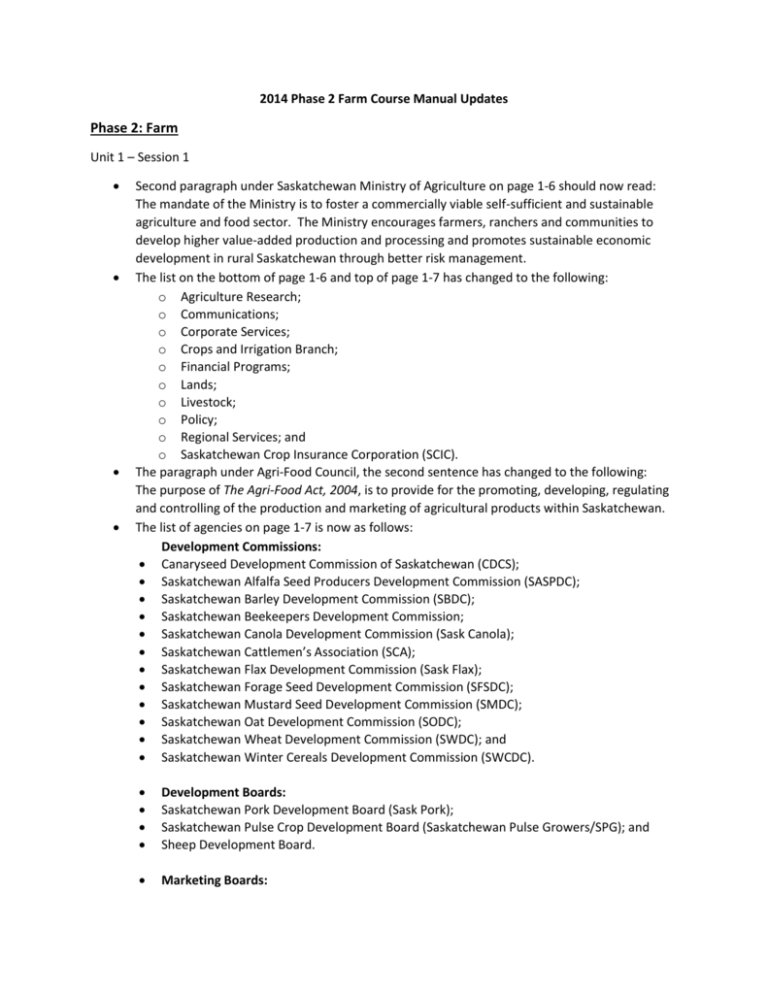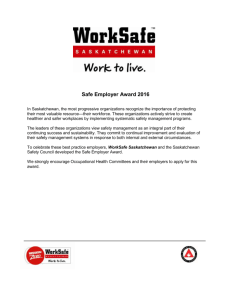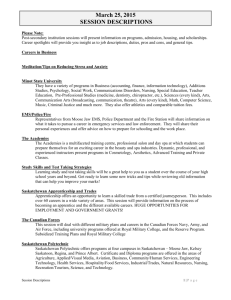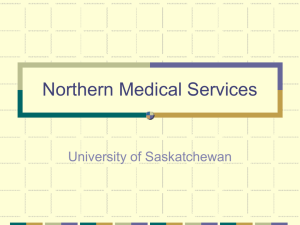2014 Updates - Association of Saskatchewan REALTORS
advertisement

2014 Phase 2 Farm Course Manual Updates Phase 2: Farm Unit 1 – Session 1 Second paragraph under Saskatchewan Ministry of Agriculture on page 1-6 should now read: The mandate of the Ministry is to foster a commercially viable self-sufficient and sustainable agriculture and food sector. The Ministry encourages farmers, ranchers and communities to develop higher value-added production and processing and promotes sustainable economic development in rural Saskatchewan through better risk management. The list on the bottom of page 1-6 and top of page 1-7 has changed to the following: o Agriculture Research; o Communications; o Corporate Services; o Crops and Irrigation Branch; o Financial Programs; o Lands; o Livestock; o Policy; o Regional Services; and o Saskatchewan Crop Insurance Corporation (SCIC). The paragraph under Agri-Food Council, the second sentence has changed to the following: The purpose of The Agri-Food Act, 2004, is to provide for the promoting, developing, regulating and controlling of the production and marketing of agricultural products within Saskatchewan. The list of agencies on page 1-7 is now as follows: Development Commissions: Canaryseed Development Commission of Saskatchewan (CDCS); Saskatchewan Alfalfa Seed Producers Development Commission (SASPDC); Saskatchewan Barley Development Commission (SBDC); Saskatchewan Beekeepers Development Commission; Saskatchewan Canola Development Commission (Sask Canola); Saskatchewan Cattlemen’s Association (SCA); Saskatchewan Flax Development Commission (Sask Flax); Saskatchewan Forage Seed Development Commission (SFSDC); Saskatchewan Mustard Seed Development Commission (SMDC); Saskatchewan Oat Development Commission (SODC); Saskatchewan Wheat Development Commission (SWDC); and Saskatchewan Winter Cereals Development Commission (SWCDC). Development Boards: Saskatchewan Pork Development Board (Sask Pork); Saskatchewan Pulse Crop Development Board (Saskatchewan Pulse Growers/SPG); and Sheep Development Board. Marketing Boards: Saskatchewan Broiler Hatching Egg Producer’s Marketing Board; Chicken Farmers of Saskatchewan (CFS); Saskatchewan Egg Producers; Saskatchewan Milk Marketing Board; and Saskatchewan Turkey Producers’ Marketing Board (STP). The last paragraph on page 1-9 should now read: The Information Services Corporation of Saskatchewan (ISC) was founded as a provincial Crown Corporation on January 1, 2000. ISC is a publicly traded Saskatchewan business corporation responsible for the development, management and administration of registries such as land titles, personal property, corporate and survey registries, as well as geographical information, and access to government services for people and business. ISC provides everyone doing business in Saskatchewan with round-the-clock, internet-based land registry and Graphic Information System (GIS) products and services. It does this through the Land Titles Automated Network Delivery System. The ISC Land System is an online, made-inSaskatchewan, land ownership record system that can graphically describe almost every piece of property in the province. Unit 1 – Session 2 Under the Sewage Disposal Systems in Saskatchewan section on page 1-61, The Plumbing and Drainage Regulations has been changed to The Plumbing Regulations. The excerpts from the act under The Plumbing and Drainage Regulations (now The Plumbing Regulations) should read: (5) No person who establishes, installs, constructs, extends, renovates, alters, repairs or operates a plumbing system or connects a plumbing system to communal waterworks or communal sewage works shall fail to comply with these regulations of the Code. (21) No person who establishes, installs, constructs, extends, renovates, alters, repairs or operates a plumbing system or connects a plumbing system to communal waterworks or communal sewage works shall fail to comply with these regulations or the Code. The heading ‘The Saskatchewan Watershed Authority Act’ is now ‘The Saskatchewan Water Security Agency Act’ on page 1-69. Under ‘The Act’ on page 1-70, the first paragraph and bullet points are now: The Saskatchewan Water Security Agency Act establishes the province’s mandate to protect provincial surface and groundwater supplies for both quality and quantity. It also allows for the management of provincially-owned water control structures such as dams and weirs. Highlights of the Act include: the management, administration, development control and protection of the water, watersheds and related land resources of Saskatchewan; the promotion of economical and efficient use, distribution and conservation of the water, watersheds and related land resources of Saskatchewan; maintenance and enhancement of the quality and availability of the water, watersheds and related land resources of Saskatchewan for domestic, agricultural, industrial recreational and other purposes; the promotion and coordination for the management, administration, development, conservation, protection and control of the water, watersheds and related land resources of Saskatchewan; the promotion, undertaking and coordination of research, investigations, surveys, studies, programs and activities relating to the management, administration, development, conservation, protection and control of the water, watersheds and related land resources of Saskatchewan; and the promotion, undertaking and coordination of conservation programs in Saskatchewan. On page 1-71, remove the third bullet point starting with “Provides for the establishment…” Unit 1 – Session 3 The information on page 1-85 should now read: Cultivated Land: The assessment of cultivated land is determined as follows: PRODUCTIVE RATING x ECONOMIC FACTORS x PROVINCIAL FACTOR = ASSESSED VALUE The productive capacity of agricultural land that is suitable for crop production is determined using a soil classification system that correlates to long-term wheat yield data. This classification system is based on the Canadian System of Soil Classification. Pastureland: The formula for pastureland is: LAND RATING x PROVINCIAL FACTOR = ASSESSED VALUE The productive capacity of pastureland is determined based on its potential carrying capacity, which is measured in terms of animal unit months (AUM), where an animal unit is a 1,000 pound cow, with or without calf. The methodology for rating the potential carrying capacity of a pasture was developed by the Saskatchewan Research Council, and takes into consideration: range site characteristics; amount of native versus seeded grass species; amount of tree cover; and depth of the water table. SAMA’s role in determining fair value for properties is just the first part of a process established by provincial legislation, The Municipalities Act. Once SAMA has determined the fair value of a property, the value is then multiplied by a percentage of value established by the provincial government for that type of property. For example, the current percentages for various types of property are given in the table found on the following page. Under the ‘Farming and the Income Tax Act’ section on page 1-91, the first sentence and bullet points should now read: Although the Income Tax Act does not specifically define farming, the CRA considers farming to include the following: tilling of soil (includes all commercial crops); livestock raising or showing; racehorse maintenance; poultry raising; dairy farming; fur farming; tree farming; fruit growing; beekeeping; cultivating crops in water or hydroponics; Christmas tree growing operating a wild-game reserve; operating a chicken hatchery; and/or operating a feedlot. In certain circumstances, you may also earn farming income from: raising fish; market gardening; operating a nursery or greenhouse; and/or operating a maple sugar bush (includes the activity of maple sap transformation into maple products if this activity is considered incidental to the basic activities of a maple sugar bush, such as the extraction and the collection of maple sap, which are farming activities). Farming income does not include income you earned from working as an employee in a farming business or from trapping. Point #2 and #3 on page 1-94 should now read: 2. Intensive Livestock Operation Regulatory Program The Intensive Livestock Operation Regulatory Program is designed to foster safe, responsible development of the agricultural industry. The Agricultural Operations Act requires operators to obtain approval for waste storage and waste management plans for intensive livestock operations. Agricultural Operations personnel provide technical support to applicants for facility design, nuisance and pollution control, waste management and public process. 3. Saskatchewan Pastures Program The Saskatchewan Pastures Program enables supplemental grazing opportunities under an equitable basis with Saskatchewan livestock farmers. Since 1922, this program has a primary focus on assisting livestock farmers by allowing grazing on Crown lands throughout Saskatchewan in exchange for a fee-for-service. The ministry hires professionals to manage the livestock, with skill emphasis in handling and care of the animals, as well as pasture management. Unit 3 – Session 1 In the Exercises on page 3-36, #9 has changed completely to: Which of the following statements is NOT attributed to the Canadian Wheat Board? (a) the current system sets out two pricing options for farmers (b) the CWB requires mandatory participation by farmers (c) strives to provide farmers with the highest return on their grain (d) sells farmers’ wheat and barley Unit 3 – Session 3 On page 3-71, the section starting “The objectives of…” the bullet points now read: o to control and regulate the production and marketing of chicken and chicken products in Saskatchewan; o to maintain a fair and stable price for chickens and chicken products in Saskatchewan that relates to the cost of production; o to initiate, support and conduct studies and research connected with the production, marketing or production and marketing of chickens and chicken products, including studies and research respecting consumer demand for Saskatchewan-grown chicken and chicken products; o to initiate, support, and conduct activities to promote the production, marketing or production and marketing of chickens and chicken products in Saskatchewan; and o to cooperate with the Governments of Saskatchewan and Canada and with any bodies empowered by an Act or an Act of the parliament of Canada or of a province or territory of Canada to market chickens and chicken products or to promote, facilitate, control, regulate or prohibit the production or marketing of chickens and chicken products. In the Exercises on page 3-81, #2 has changed to: List the information required to provide the board to obtain a license under The Saskatchewan Chicken Marketing Plan Regulations. Unit 4 – Session 1 The last paragraph and bullet points on page 4-25 should now read: According to The Private Sewage Works Regulations from The Public Health Act, the following specifications for septic tanks are legislated: be of a design acceptable to the local authority; have a total sewage holding capacity of at least 4,546 litres; be accessible to vehicles providing sewage removal service; except for lagoons, all components of a private sewage works must have adequate protection from freezing; and odours must be minimized. The second paragraph and bullet points on page 4-27 should now read: According to The Private Sewage Works Regulations from The Public Health Act, 1994, except with the written approval of the local authority, no sewage or effluent is to be discharged: into surface water; on to the ground surface or into the subsoil within the limits of any city, town, village, resort village, northern village or residential area, or within one kilometer of its boundary; into the subsoil within ten meters of any dwelling; on to the ground surface within 30 meters of any dwelling; on to the ground surface or into the subsoil within 15 meters of a drilled well or within 30 meters of any other well or water supply used for domestic purposes; or into a storm sewer. Unit 5 – Session 5 The bullets on the bottom of page 5-139 and top of page 5-140 should now read: o the date on which the offer is made; o the names and addresses of the buyer and seller; o the street address or legal description of the real estate; o the price offered by the buyer and the terms and conditions of the offer; o the amount of deposit, if any, made at the time of the offer and whether or not that deposit is to form part of the price; o a brief description and list of any chattels that are to be included in the price; o the date of possession by the buyer and whether possession is to be vacant or otherwise; o the date of adjustments; o the time and date by which the offer is to be accepted; o the name, address and telephone number of the brokerage; and o any other information prescribed in the bylaws. The second bullet point on page 5-156 delete from “upon receipt of the deposit” all the way to the end of that point. Delete form on page 5-157. Appendix On page A-9, Unit 3, Session 3, #2, the new answer is: Address, telephone number, fax number or email address; the legal land description for the production location; a site plan for the production location; other information or material that the board may reasonably require. On page A-13, Unit 5, Session 5, #1, the new answer is: the date on which the offer is made; the names and addresses of the buyer and seller; the street address or legal description of the real estate; the price offered by the buyer and the terms and conditions of the offer; the amount of deposit, if any, made at the time of the offer and whether or not that deposit is to form part of the price; a brief description and list of any chattels that are to be included in the price; the date of possession by the buyer and whether possession is to be vacant or otherwise; the date of adjustments; the time and date by which the offer is to be accepted; the name, address and telephone number of the brokerage; and any other information prescribed in the bylaws. Examination Study Guide #1, answer #1 should just read “Livestock” #3 should now be: Which of the following statements is NOT applicable to the purpose of The Agri-Food Act, 2004 in the production and marketing of agricultural products within Saskatchewan? 1. provides development 2. sets prices 3. provides promotion 4. regulates and controls #44 should read The Saskatchewan Water Security Agency Act. #55 answer 1 should read: Intensive Livestock Operation Regulatory Program and answer 4 should read: Saskatchewan Pastures Program. #138 should read Saskatchewan Water Security Agency. #145 and #146 should read The Private Sewage Works Regulations instead of The Plumbing and Drainage Regulations.







